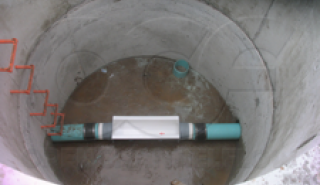Beyond the normal approach and installation problems, there are a number of factors can affect the accuracy of a Palmer-Bowlus flume measuring flow. These include: approach channel conditions, deposits, Froude number, longitudinal slope, and roughness.
Approach Channel
Approach conditions that cause non-uniform velocity distributions will tend to result in upstream depths (and thus computed discharges) to be too low. The size of the error increases as the ratio of upstream velocity to depth increases. Roughness in the upstream channel is one common source of non-uniform velocity distributions.
Deposits
Deposits in inlet of the flume – upstream of the throat ramp – form a change in geometry, for which the flow equation must be adjusted.
Froude Number
Excessively energetic flows – those with Froude numbers greater than 0.6 – will be conducive to the formation of standing waves which may make the determination of the true depth at the point of measurement difficult.
Longitudinal Slope
If the Palmer-Bowlus flume is sloped down in the direction of flow, the control point shifts from the downstream edge of the throat ramp upstream. This departure can cause an error of unspecifiable magnitude in the discharge measurement – baring field calibration.
Small upward slops (flume outlet higher than flume inlet) can be corrected by setting the zero reference point at the same level as the uppermost edge of the throat ramp.
Roughness
Excessive roughness upstream in the approach channel can result in non-uniform velocity distributions.
In the flume, excessive roughness will decrease the discharge coefficient (Cd) of the flow equation due to increased energy loss and boundary layer thickness – the flume will pass less flow than would otherwise be assumed based upon the depth reading only.
The roughness of the flume should not be greater than that of smooth concrete. Greater than this and the flow is retarded.
Source: Recommended Practice for the Use of Parshall and Palmer-Bowlus Flumes in Wastewater Treatment Plants





